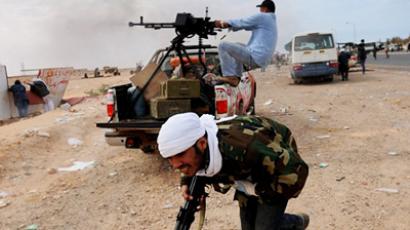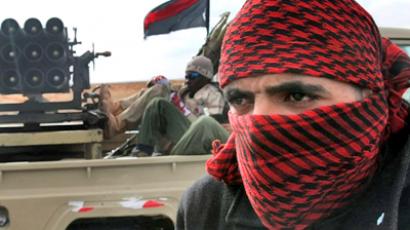“Protecting” Libyans with a silent killer

With the Libyan rebels rejecting an African Union peace plan, there seems to be no end in sight for the conflict. The opposition is still relying on coalition forces to help its cause, but it seems they could prove more of a hindrance.
It has been claimed the allies have used depleted uranium in their attacks – a substance which causes cancer and mutations in those affected.Libyan rebels could be seen climbing on a tank to celebrate one of the coalition’s latest successful strikes, unaware of the silent killer they may have been breathing in. Gulf War veteran and depleted uranium expert Melissa Sterry believes the rebels on the tank would have been getting low-level radiation exposure. Though the western coalition denies using depleted uranium in bombings in the country, others say there is a good chance weapons with the highly poisonous radioactive element have been used. “With that kind of damage, there is a pretty good chance it was a DU [depleted uranium] round. I am about 80-90 per cent sure it was a DU round. That is very stupid… The level of the wind blowing, that means the particles … so all these people in the cars are exposed,” explains Sterry. Sterry served in the US military during the first Gulf War in the early 1990s, clearing-up battlefields in Kuwait. Back then the US dropped more than 350 tons of depleted uranium over Kuwait and Iraq. The pictures of bombings in Libya seem all too familiar. “You see how there are touches of red?” Sterry says, watching footage of the bombings. “That is the burning. See how it shoots out instead of concentrated up and the flare at the bottom? That is a depleted uranium explosion.”Depleted uranium in military terms is highly efficient – relatively cheap and powerful enough to penetrate the heaviest armor. NATO flatly denies its use in Libya. Even though the UN human rights commission has called for a ban, countries which have refused to sign up include the US, the UK, France and Israel.Investigative journalist Dave Lindorff is not surprised by NATO’s denial of the use of depleted uranium in Libya.“The only people who could blow the whistle would be the pilots and the people that are actually putting the ammunition onto the planes,” he said. “They are in the military, and they are not talking.”
The smallest particles of uranium, nanoparticles, are the most dangerous. Once inhaled, they get into the blood and can spread into any organ, including the heart, brain, liver. Once the particles penetrate cell tissue, all kinds of genetic mutations can develop. People in Iraq, for example, breathe in the contaminated air every day. And experts say there is no way to fight it. In the Iraqi city of Fallujah, where the US dropped thousands of depleted uranium rounds after the 2003 invasion, a quarter of all babies are born with a range of horrendous abnormalities. Higher rates of cancer, leukemia and infant mortality have been found there than in Hiroshima and Nagasaki after the atomic bombs were dropped. The US and the British military admitted widespread use of depleted uranium in bombing Bosnia in 1995 – a legacy felt today with cancer and leukemia rates several times higher than normal among locals. “We have got total medial confirmation all around Iraq that the effects of the uranium are there. We see it throughout Iraq, Saudi Arabia, Kuwait, Afghanistan, Somalia, Balkans, now we see it moving into Libya,” says Doctor Doug Rokke. He was a leading specialist in the clean-up after the Gulf War and says there is no way of actually decontaminating affected areas. “I was given a written memorandum to lie about the effect of depleted uranium,” claims Rokke. He himself was exposed to depleted uranium and has cancer. Almost all of the other members of his team are now dead.The First Gulf War left one in four American soldiers disabled. Only around 260 veterans were tested for depleted uranium, out of almost 700,000 deployed for the war. “Every time I asked to be tested for exposure to depleted uranium, people have refused to give me the test,” says Melissa Sterry.Some fear that the suffering of those bombed – in areas where there are no western troops – will go unnoticed. Depleted uranium has a half-life of 4.5 billion years – hence its description by some as the silent killer that will never stop killing.“This is forever, essentially, and the danger to it is because it’s very heavy, uranium is extremely heavy. It sinks down low into the ground, and it gets into the water channels. So the problem will be that 20, 30 or 40 years from now, you’re going to have the steady leakage of both toxic metals and uranium into the water channels of these villages,” journalist Conn Hallinan told RT.“There is essentially no defense against the depleted uranium shell,” he added. “So, of course, if you run a war, you want to have depleted uranium ammunition, and the US is now trading and selling it to a large number of its NATO allies and non-NATO allies, about 25 countries in the world. There are some countries that refuse to use it, for instance, Germany and Italy, and Belgium is the first country to actually ban its use.”














